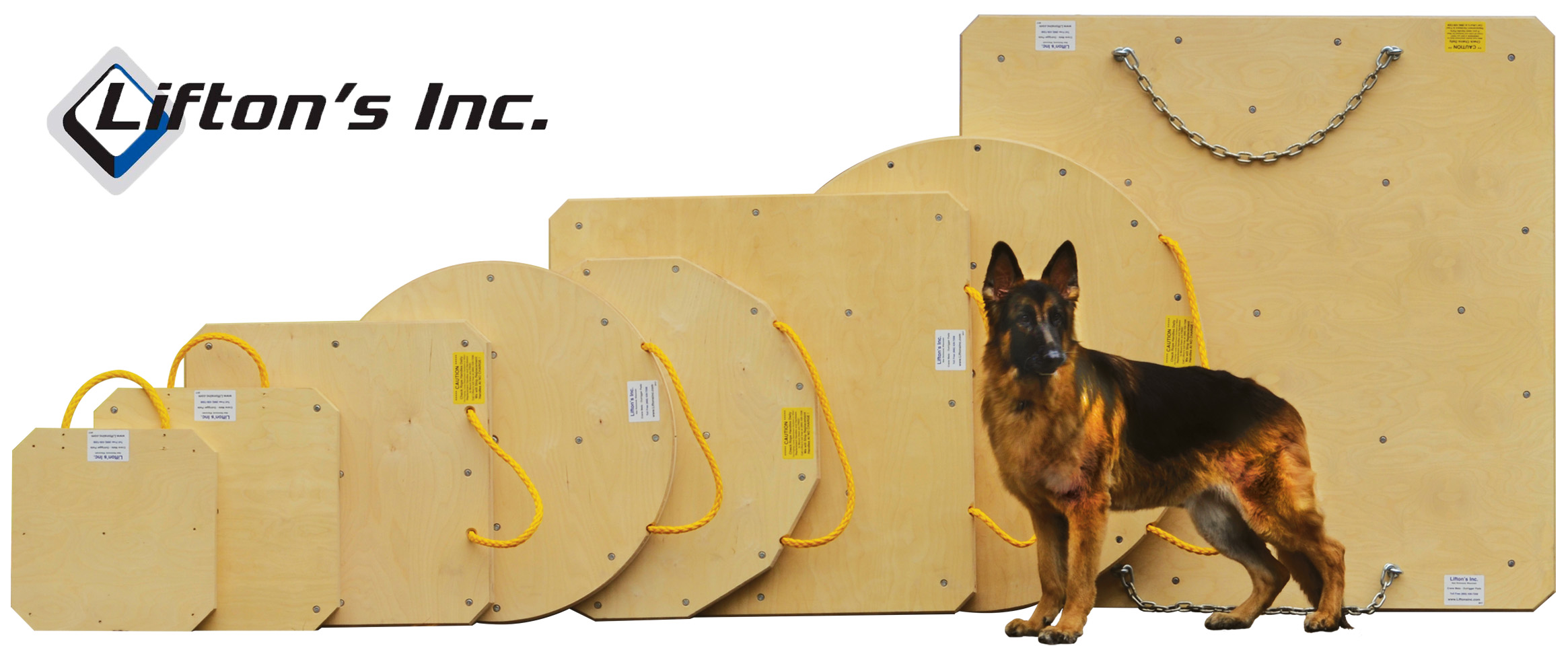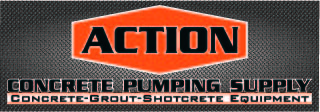Getting ready to pump concrete: Priming a boom
Ok, we have got the boom set-up in a satisfactory way; we know what we are pouring and what we need to do. Let's say we are using a 4" hose off the boom with a 5 to 4 reducer. Try to use the best hose available here. Because it is hanging above everyone and will be heavy (even when empty) we want a hose that has good ends. I don't want to field test the safety straps. A worn or old hose may blow at the end or a coupling may come apart from wear. The same applies to the reducer. The end can wear through and simply break off with the slightest back-pressure. Have a good one hanging from the boom. Have your safety straps or cables in place and anchored to a fixed point on the boom. Never depend on these safety devices, but always have them in place. Now we need a place to prime. Ask the customer where the best place is. Don't put it in the form unless the customer tells you to. NEVER prime with gel in the form. Depending on the type of boom that you have, set the boom so it is either section up or down. Don't try to prime with a section flat or horizontal. The idea is to lubricate the pipeline and a section that is horizontal will have the water or slurry run down the bottom half of the pipe leaving the upper half dry. Concrete will still fill the pipe because it is so much denser and heavier than the prime. it can get ahead of some of the prime this way and at least make the first several strokes contaminated, at worst in can plug trying to travel down a half dry pipe. So, boom sections up and down. You will push it up, gravity will help it down. When the prime reaches the hi-point of the boom, it will flood the down sections wetting the pipe. This is where counting strokes pays off. Once it has started its down hill run, the wettest stuff will pour out quickly; pump as little concrete as possible after this to avoid wasting the mud and making more mess to be cleaned up. Pump enough to get all the prime out especially if you are using a gel. Watch the build up of pressure as you are priming. Learn to "feel" the machine and know when it is laboring to pump. Using only part throttle helps because you can feel or hear it load down when pressure is building. If it plugs for some reason, you will need to react quickly to avoid blowing a pipe and/or making the plug packed in too tight. If caught early, a plug can easily be worked out with out ever breaking anything open. Try to have the slump of the mud correct when you prime. Having to prime with dry mud and getting only halfway through the prime and having the chute plug can ruin your day. Never stop priming until it is complete. Stopping will allow the water and concrete to separate causing a plug. Keeps it moving? This is one of the more important steps in pumping a job. It will set the tone for the entire pour. If trouble comes your way on the prime, chances are the problems will snowball and the job will be a step behind all day. Take the time to do this well. Now I will detail one of the preferred methods of priming a boom. Pumping.
Priming a boom pump is something we all do everyday; Most of the time we don't have much trouble. Every once in awhile, it's just your turn to have hell. There is an old saying in the pumping business, "the first yard is the hardest" there is a reason for this cute little quote and we are going to explore everything that has anything to do with a good start in order to have a good day. First of all, your prime, the ease or difficulty has a lot to do with your wash out the last pour. Concrete pumps because cement is real slippery and CLEAN smooth surfaces promote the sliding of concrete through a pipeline. The cleaner the boom pipes the easier the prime. So, let's step back, to yesterday. A water-wash out is great. If done right you will have a boom cleaner that the day the pipe was installed. A sponge has been the standard for many years and will work just as well, if, used properly. And finally, air blow out is usually the last resort saved for when nothing else works. It takes water to clean. Air won't do it, neither will a sponge. When sucking a sponge, remember what is really happening. You are applying a vacuum to a boom and the higher air pressure on the other side of the sponge pushes as much as the vacuum pulls. When a sponge is being pulled, it tends to squeeze down in size as the vacuum pulls it. As this happens, it will not scrape the walls of the pipe as well as you would think. The further it travels, the smaller it has become. Finally, it is loose in the pipe and you are leaving a thin layer of concrete (mostly grout), on all sides of the pipe. This is where water comes in... Water will seal the sponge as oil seals the rings in the cylinder of an engine. With a good seal, most or all the material will stay ahead of the sponge, thus leaving a clean pipe. Air blowing has a similar effect. Water again will solve the problem. Most sponges are soft enough to collapse to some degree leaving the potential for a pipe that is 1/4" smaller than you think it is. And rough as hell too. Not conducive to a good prime tomorrow. When using water and sponges, first pour 3 or 4 gallons in the tip elbow or hose, insert the sponge, stuff it in a little ways then pour the remaining water in on top of it. 1 bucket will do fine. Start sucking in reverse and if you watch, you will see the water being pulled through the sponge. It is doing its job sealing. The sponge will move and you are on the way home! Always suck back slowly. The faster you suck, the more the sponge will collapse and leave residue. Also, the sponge or ball is usually round, allowing it to ride over some concrete in the pipe. Water will also help wash the entire residue with the ball. Slowly will work, may take a minute more but it will work. If you are having trouble getting the ball to start moving, cover the elbow or hose end where you put the ball and run the pump in reverse. You will feel the vacuum. What you are doing is creating a deeper vacuum and when you release the opening, the ball is hit with air pressure that pushes it through and the vacuum will continue pulling it. Water will seal it and help wash the pipe clean.
Now that we did a good washout yesterday, we can prime today. If you have a pump with a prime port, it's a really cool thing and can be used to insure a good prime. Cycle the pump forward and as soon as the valve changes, stop. Think about this. You have stopped when a piston is all the way at the bottom of the stroke ready to pull concrete in the cylinder. The valve covers the other hole as if it were pushing mud in the valve and to the pipeline. Using the prime port will put water where it should be, in front of the concrete and the two will not meet until the pump is cycling. This is the best way to prime with water or anything else. Allowing the prime (water, slurry or gel) to mix with the concrete too soon can cause a separation plug and/or not allow prime to wet the pipe before concrete gets there causing a dry plug. Its too easy to send a 1/2 stroke of concrete into the deck pipe then a shot of water then more concrete depending on where your valve was and when you turned the pump on. Easy mistake and it happens often. Ever felt a quick pressure up, and then it breaks free? You were close to a bad day! The whole trick is to keep the prime whatever it is in front of the concrete. Priming a boom pump really has nothing to do with priming as most understand it to be, all it does is lubricate the dry line until the self lubricating concrete passes and leaves its layer of slick cement slurry on the walls of the pipe. It could be called "wetting" the pipeline but that sounds like something that would be done if the priming did not go well. As in wetting your pants!
Do you know how many strokes it takes your pump to get mud out the end of the boom? This can be useful knowledge when priming. You can tell when it should be pouring out the prime material. If it takes more strokes, say normally 8 strokes and the water is pouring out, and you have gone 12, then you know the water is not up front and should be prepared to react to a plug. Concrete is in front and you are having to push it every inch of the way through your boom. Remember that the first yard is the hardest! Or, can be. Be quick on the on/off switch and ready to "work" it through should you plug on the prime. With a tight valve, you can stand the boom straight up, use gravity to help, and suck it back, counting the strokes back. Ten back, eleven forward till it hangs again. 8 back, and then try 9 forward. You can do this until you get all the way through. If you know how many strokes your entire boom takes, you will know when to lay it down again. Avoid pumping mud and letting it fall from a long distance up, lots of splatter and possible damage. Once you get it moving through most of the boom easily, drop the last section to a normal height and go for it. The worst that can happen is that you may have to repeat the process a couple times but it will work. If you happen to plug in the tip elbows, stand it up and reverse it. As soon as the plug has pulled apart, you will see a little rock and sand fall from the tip hose. That's the sign that it is free. A plug in a reducer usually means getting the hammer out and breaking it off. Always cycle in reverse to relieve pressure before opening any clamp anywhere. And when priming with anything and under any circumstance, there is no need to prime at wide open and 100% volume. Doing this will reduce the time you have to react to a plug and there is a possibility of blow something apart. Half throttle and less than full volume should work fine. If done right, you should almost be able to idle a prime.
If you don't have a prime port, and are using water only, try to have the same pump piston position, one all the way down and put enough water in the hopper to start to enter the open cylinder. When you turn on the pump, the first thing entering the cylinder will be water. Try to fill the hopper with mud from the opposite side so the mud will chase the water into the open cylinder. Turn the pump on when most of the water has been chased into the hole and you're off! I see guys letting the pump cycle with water in the hopper as the mud falls into the thing. When doing this, you are getting a lot of rock and washed out stuff in the first stroke and adding to the potential of a separation plug. Remember that the whole idea is to keep the prime in front of the mud to lube the pipeline, not mix the two in the valve. If you know your machine well, you should be able to turn it on, start pumping and without looking, know when the water is pouring out. There should be no need to pump 1 yard on the ground to get the entire prime out. Most customers will appreciate as little prime mess as possible and as little wet in their forms as possible. It all comes down to knowing your pump and some simple planning. Once you get past the first yard, the remaining 100 or 1000 are easy. The way you start your pour pretty much sets the tone for the entire pour.
Priming with slurry is pretty much the same, except I like some water in front of the slurry to keep it loose while hitting the dry pipe. Gel takes a little more effort because you must not let it mix with the mud anymore than possible. The customer gets really mad when they pull forms a day or two later and find a big soft spot that is gel and will not get hard in this lifetime. So, making sure you keep gel ahead of the mud is really important and not permitting it to get in to the form. It's harder to tell where it ends in priming and good mud begins, so doing it right will help avoid any potential problems.
In the future, we will talk about priming with system on, or to be clamped up after the boom prime and some options there. We will also talk more about the many wash out options. What you do there often determines how well you start tomorrow. There are ways to do a good wash out, quickly, effectively, and safely, no matter what the situation is. We will explore them all.
Following these easy techniques will make your day easier and your customer happier, resulting in a job well done!
Written By Horton, Lee Published by ConcretePumping.com

_1.png)


















.jpg)
.gif)

.jpg)









.jpg)








